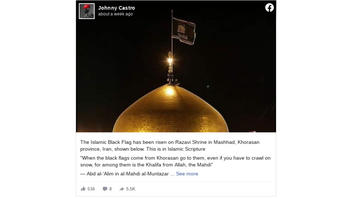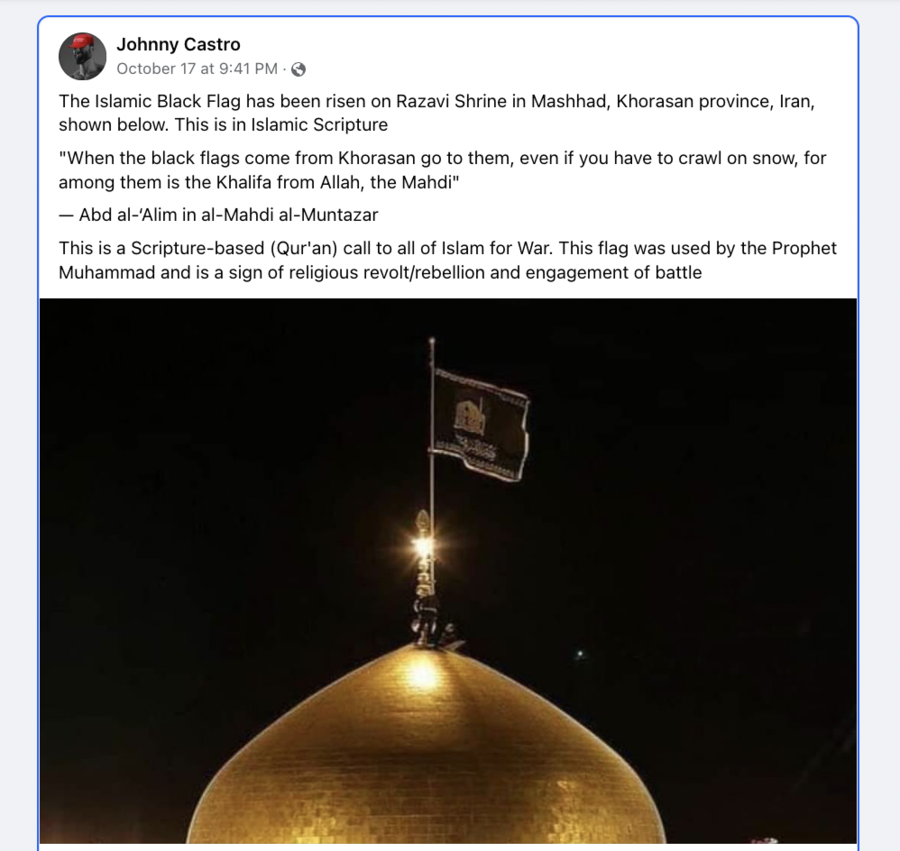
Was a black flag that appeared over Razavi Shrine in Iran in October 2023 meant to express a "call to all of Islam for War"? No, that's not true: In this particular case, it was a symbol of mourning, as the Facebook account for the shrine itself wrote. While extremist groups have hijacked the symbolism of black flags in recent decades, the banner over the shrine had no resemblance to their versions of the black flag.
The claim appeared in a post (archived here) on Facebook on October 17, 2023. It stated:
The Islamic Black Flag has been risen on Razavi Shrine in Mashhad, Khorasan province, Iran, shown below. This is in Islamic Scripture'When the black flags come from Khorasan go to them, even if you have to crawl on snow, for among them is the Khalifa from Allah, the Mahdi'-- Abd al-'Alim in al-Mahdi al-MuntazarThis is a Scripture-based (Qur'an) call to all of Islam for War. This flag was used by the Prophet Muhammad and is a sign of religious revolt/rebellion and engagement of battle.
This is what the entry looked like on Facebook at the time of writing:
(Source: Facebook screenshot taken on Thu Oct 26 13:44:17 2023 UTC)
The Imam Reza Holy Shrine located in Mashhad, Iran, also known as the Razavi Shrine, however, explicitly described the black flag as a symbol of mourning on its Facebook page (archived here) on October 17, 2023, connecting the gesture to the loss of people's lives in that day's Gaza hospital explosion:
Mourning flag over the dome of Imam Reza's shrine
That came with a cancellation of drum beating on the next day, which also points toward an expression of grief rather than a war cry, even though paired with explicit accusations toward Israel for what happened.
Moreover, the gesture is consistent with the national day of mourning (archived here) announced by Iran's government on the same occasion.
A 2015 Atlantic article, written years before the 2023 Hamas-Israel conflict to examine the origins of the ISIS flag -- which is also black -- explained that while over the course of history black banners were known as battle flags in Islam, many practicing Muslims use black flags to mark religious holidays.
It is worth pointing out that the ISIS flag looks different from what was seen in the images of the shrine. The former, for example, utilized white inscriptions, not yellow, and an emblem was below the words. The images of the mourning flag are in the opposite order. Furthermore, the emblem on the flag in question on social media has a very straightforward meaning: It's a logo of the shrine that can be found in the top right corner of its website (archived here).
A 2014 academic article published in the Counter Terrorism Trends and Analysis magazine points out that mentions of the black flag do not come from the Quran -- they come from the Hadith, a group of religious texts written much later whose meaning and authenticity continue to be debated among religious scholars. The Hadith provides a broad range of possible meanings for the black flag ranging from a symbol of struggle to expression of solidarity with a group.
The article concludes:
... the black flag has no clear figurative meaning in Islam.
That explains why the context surrounding its use is important to understanding each particular case.
As the AP wrote, the tradition of seeing it as a symbol of mourning comes from the fact that the black flag also symbolizes Muharram -- "the first month of the Islamic calendar, in which Shiite Muslims commemorate the death of Imam Hussian, grandson of the Prophet Muhammad." That, for instance, happened (archived here) in July 2023.
Had the meaning of the black flag been different in the case of the Imam Reza Holy Shrine in October 2023, that would have been verbally expressed as such.
But Iranian news websites (for example, here and here) referred to it as an expression of mourning.
In October 2023, no credible news sources (archived here) reported that Iran called "to all of Islam for war."
U.S. officials described Iran's role in the 2023 conflict as being "broadly complicit" with the Hamas agenda but found no evidence of its direct involvement in the October 7, 2023, attack on Israel.
In the aftermath of the October 17, 2023, hospital blast in Gaza, both sides of the conflict blamed each other. The event sparked mass protests against Israel in Muslim countries and beyond. Later, however, U.S. intelligence said with "high confidence" that the explosion was likely caused by a malfunctioning Palestinian rocket. By October 24, 2023, as more information became available about the blast, several major English-language news that relied on Hamas sources backtracked their stories about the explosion.
Other Lead Stories fact checks about the 2023 Hamas-Israel conflict can be found here.













